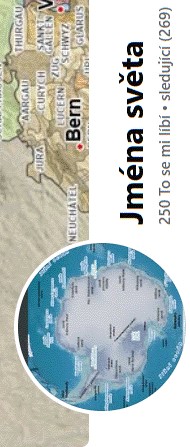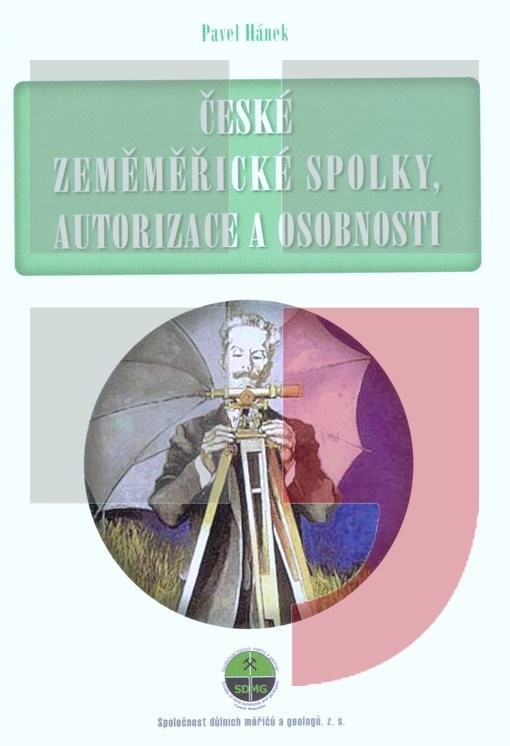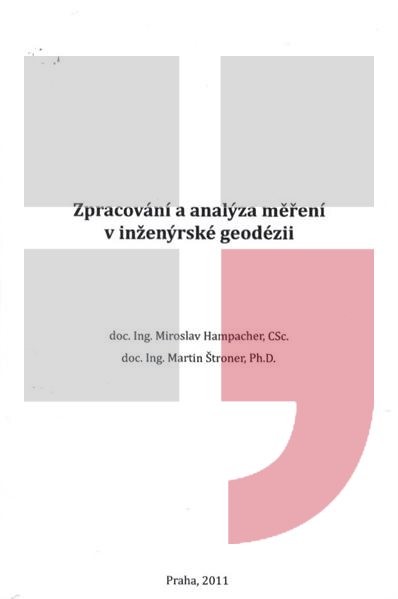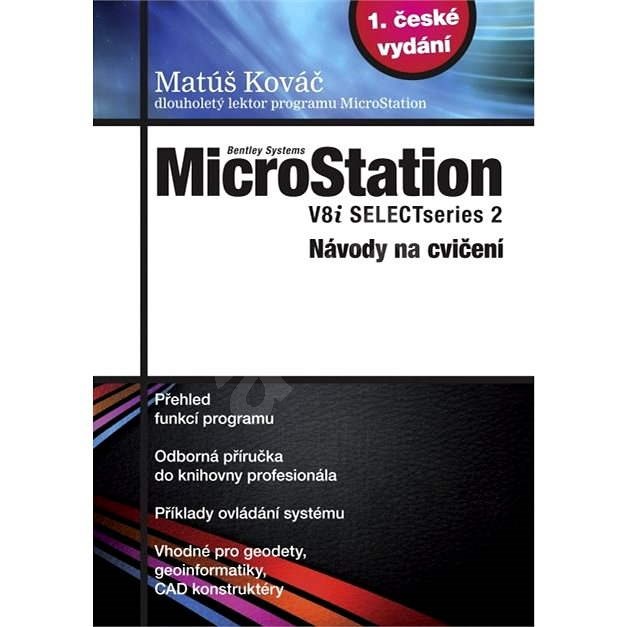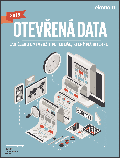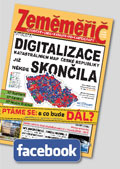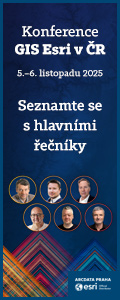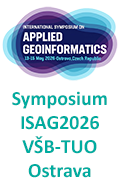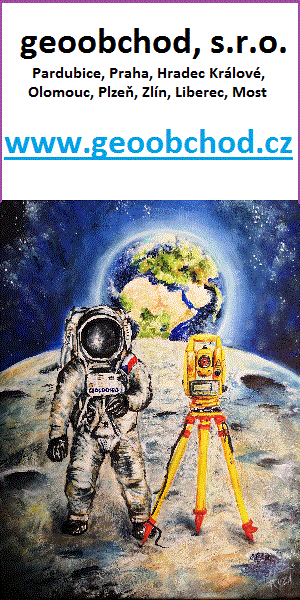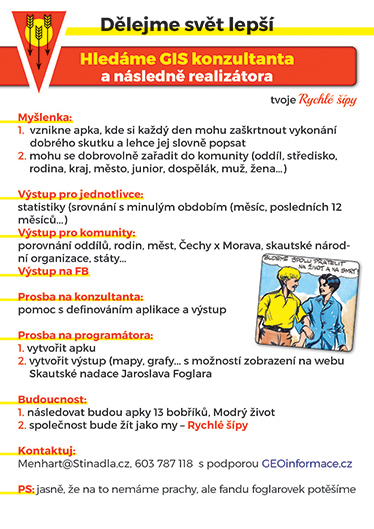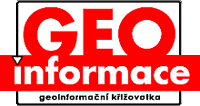zprávy
zdroje zpráv:Geologické regiony - oblastní geologové
11.5.2017 2:00 Cenia - Katalog metadat ČR - INSPIRE Regionální geologické členění České republiky doplněné o informace o zodpovědných oblastních geolozíchVARS/Transoft User Day
11.5.2017 2:00 VARS.czTato událost je jedinečnou příležitostí seznámit s aktuálními novinkami aplikací společnosti Transoft Solutions: programy pro vlečné křivky AutoTURN / AutoTURN PRO (3D) – nová česká verze, dále novinka AutoTURN OnLine, programy pro návrh parkovišť ParkCAD a areálů SITE CEM, pro návrh kruhových a klasických křižovatek TORUS / NEXUS. Přijďte a připojte se k nám v Brně 1. června 2017.
Stratigrafické členění - kódy
11.5.2017 2:00 Cenia - Katalog metadat ČR - INSPIRE Databáze obsahuje kódovníky stratigrafického členění.1. národní workshop projektu ATTRACTIVE DANUBE, zaměřený na téma národní indikátory
10.5.2017 17:01 CENIA - národní geoportál INSPIRE CENIA, česká informační agentura životního prostředí si Vás dovoluje pozvat na 1. národní workshop projektu ATTRACTIVE DANUBE, zaměřený na téma národní indikátory. Workshop proběhne ve čtvrtek 8. června 2017 od 10:00 do 14:30 v prostorách Ministerstva životního prostředí (Vršovická 1442/65, Praha 10). Více informací spolu s předběžným programem naleznete zde. Pro bezplatnou účast na akci je nutná...Odborný referent - zápisy v řízení V a Z (1)
10.5.2017 14:40 ČÚZK - volná místa Katastrální úřad pro Plzeňský kraj, Katastrální pracoviště Plzeň-jih vypisuje výběrové řízení na místo Odborný referent - zápisy v řízení V a Z (1)Odborný referent - zápisy v řízení V a Z (1)
10.5.2017 14:40 ČÚZK - předpisy a opatření Katastrální úřad pro Plzeňský kraj Katastrální pracoviště Plzeň-jihvypisuje výběrové řízení na místo
Odborný referent - zápisy v řízení V a Z
Odborný referent - zápisy v řízení V a Z (1)
10.5.2017 14:40 ČÚZK /Urady/Katastralni-urady/Katastralni-urady/Katastralni-urad-pro-Plzensky-kraj/Uredni-deska/Oznameni-a-jina-uredni-sdeleni/Volna-mista/Odborny-referent-zapisy-v-rizeni-V-a-Z-(1)20170510 Asistent/asistentka ředitele služebního úřadu
10.5.2017 13:51 ČÚZK /Urady/Katastralni-urady/Katastralni-urady/Katastralni-urad-pro-Stredocesky-kraj/O-uradu/Aktuality/20161013Rada-odborny-rada-–-informatik-(1)20170510 Asistent/asistentka ředitele služebního úřadu
10.5.2017 13:51 ČÚZK - předpisy a opatření V části "Úřední deska", v sekci "Oznámení a jiná úřední sdělení" bylo vystaveno "Oznámení o vyhlášení výběrového řízení na obsazení systemizovaného místa Asistent/asistentka ředitele služebního úřadu pro Středočeský kraj"IdeaHack aneb Pomozte nám vymyslet co všechno by se s open daty dalo v Brně dělat
10.5.2017 13:50 Otevřená data Přijďte na zahřívací akci k opendatovému hackathonu BrnoHacks a zapojte se s námi do brainstormingu o tom, jak ze spojení Brna a otevřených dat využít co nejvíc!20170510-VŘ Administrace databází (11. a 13. platová třída) a Administrace systémového managementu
10.5.2017 12:32 ČÚZK /Aktuality-resort/2017/20170510-VR-Administrace-databazi-(11-a-13-platova20170510-VŘ Administrace databází (11. a 13. platová třída) a Administrace systémového managementu
10.5.2017 12:32 ČÚZK - předpisy a opatření Oznámení o vyhlášení výběrových řízení na služební místa - Administrace databází (11. platová třída), Administrace databází (13. platová třída) a Administrace systémového managementu.Asistent/asistentka ředitele služebního úřadu
10.5.2017 12:31 ČÚZK /Urady/Katastralni-urady/Katastralni-urady/Katastralni-urad-pro-Stredocesky-kraj/Volna-mista/asistent-asistentka-reditele-sluzebniho-uraduAsistent/asistentka ředitele služebního úřadu
10.5.2017 12:31 ČÚZK - předpisy a opatření Katastrální úřad pro Středočeský krajvypisuje výběrové řízení na místo asistent/asistentka ředitele služebního úřadu
Asistent/asistentka ředitele služebního úřadu
Asistent/asistentka ředitele služebního úřadu
10.5.2017 12:31 ČÚZK - volná místa Katastrální úřad pro Středočeský kraj, vypisuje výběrové řízení na místo Asistent/asistentka ředitele služebního úřaduAdministrace systémového managementu (1)
10.5.2017 12:07 ČÚZK - předpisy a opatření Český úřad zeměměřický a katastrálnívypisuje výběrové řízení na místo
Administrace systémového managementu
Administrace systémového managementu (1)
10.5.2017 12:07 ČÚZK /Urady/Cesky-urad-zememericky-a-katastralni/Uredni-deska/Oznameni-a-jina-uredni-sdeleni/Volna-mista/Administrace-systemoveho-managementu-(1)Administrace systémového managementu (1)
10.5.2017 12:07 ČÚZK - volná místa Český úřad zeměměřický a katastrální, vypisuje výběrové řízení na místo Administrace systémového managementu (1)Mapová aplikace byla aktualiz
10.5.2017 12:00 Jihočeský kraj Mapová aplikace byla aktualizována k 10.5.2017.Mapová aplikace Technická infr
10.5.2017 12:00 Jihočeský kraj Mapová aplikace Technická infrastruktura byla aktualizována k 10.5.2017.European GNSS Agency (GSA) launches 2017 GNSS Market Report
10.5.2017 11:27 European GNSS Agency
In the fast evolving world of satellite navigation technology and GNSS applications, monitoring the landscape and having the latest information is essential. With its in-depth look at market opportunities and trends across eight market segments, the GSA’s 2017 GNSS Market Report is a key resource for successfully navigating this exciting market.
The growing demand for precise location information, in combination with the ongoing evolution of GNSS technology, means that today’s GNSS market is bigger than ever. According to the 5th edition of the GSA’s popular GNSS Market Report:
- The global GNSS market is expected to grow from 5.8 billion devices in use in 2017 to an estimated 8 billion by 2020.
- The GNSS downstream market is expected to produce over € 70 billion in revenue annually in 2025. When the revenue created by added-value services is included, this number could more than double.
- The global GNSS downstream market is forecast to grow by more than 6 % annually between 2015 and 2020.
- Following the declaration of Galileo Initial Services in 2016, chipset and receiver manufacturers and application developers are leveraging Galileo signals, and a number of Galileo-ready devices are already on the market.
- By 2025, the installed base of GNSS devices in drones will reach 70 mln, more than twice the sum of other professional market segments combined.
A go-to resource
Regularly referenced by policy-makers and business leaders around the world, the GNSS Market Report serves as the go-to resource for an in-depth look at GNSS market opportunities and trends across an array of essential market segments.
“Providing in-depth information on today’s GNSS market opportunities and a data-driven forecast of its evolution through to 2025, this edition is a must-read for anyone looking to successfully navigate this promising market,” says GSA Executive Director Carlo des Dorides.
New edition, new additions
The GNSS Market Report takes a comprehensive look at the global GNSS market, providing a thorough analysis per market segment (Location-Based Services (LBS), Road Transportation, Aviation, Maritime, Rail, Agriculture, Surveying and Timing & Synchronisation), region and application type, including information on shipments, revenues and installed device base. This edition includes such new features as:
- An expanded section on macro-trends like the Internet of Things (IoT), Smart Cities and Big Data.
- Segment-specific user perspectives, with an emphasis on the increasingly stringent demands of today’s GNSS users.
- The unique added-value that European GNSS (EGNOS and Galileo) brings to each segment and how Galileo is already enhancing the functioning of many applications.
- A special feature on the important role that GNSS plays in the growing market of drones (i.e., UAVs/Remotely Piloted Aircraft Systems).
The full 100-page report is available for download free of charge at: www.gsa.europa.eu/market/market-report.
About the European GNSS Agency
As an official European Union Regulatory Agency, the European GNSS Agency (GSA) manages public interests related to European GNSS programmes. The GSA’s mission is to support European Union objectives and achieve the highest return on European GNSS investment, in terms of benefits to users and economic growth and competitiveness.
Methodology
The GSA GNSS Market Report is compiled by the GSA and the European Commission and was produced using the GSA’s systematic Marketing Monitoring and Forecasting Process.
The underlying market model uses advanced forecasting techniques applied to a wide range of input data, assumptions, and scenarios to forecast the size of the GNSS market in terms of shipments, revenue, and installed base of receivers.
Historical values are anchored to actual data in order to ensure a high level of accuracy. Assumptions are confronted with expert opinions in each market segment and application and model results are cross-checked against the most recent market research reports from independent sources before being validated through an iterative consultation process involving pertinent sector experts and stakeholders
Media note: This feature can be republished without charge provided the European GNSS Agency (GSA) is acknowledged as the source at the top or the bottom of the story. You must request permission before you use any of the photographs on the site. If you republish, we would be grateful if you could link back to the GSA website (http://www.gsa.europa.eu).
European GNSS Agency (GSA) launches 2017 GNSS Market Report
10.5.2017 11:27 European GNSS Agency
In the fast evolving world of satellite navigation technology and GNSS applications, monitoring the landscape and having the latest information is essential. With its in-depth look at market opportunities and trends across eight market segments, the GSA’s 2017 GNSS Market Report is a key resource for successfully navigating this exciting market.
The growing demand for precise location information, in combination with the ongoing evolution of GNSS technology, means that today’s GNSS market is bigger than ever. According to the 5th edition of the GSA’s popular GNSS Market Report:
- The global GNSS market is expected to grow from 5.8 billion devices in use in 2017 to an estimated 8 billion by 2020.
- The GNSS downstream market is expected to produce over € 70 billion in revenue annually in 2025. When the revenue created by added-value services is included, this number could more than double.
- The global GNSS downstream market is forecast to grow by more than 6 % annually between 2015 and 2020.
- Following the declaration of Galileo Initial Services in 2016, chipset and receiver manufacturers and application developers are leveraging Galileo signals, and a number of Galileo-ready devices are already on the market.
- By 2025, the installed base of GNSS devices in drones will reach 70 mln, more than twice the sum of other professional market segments combined.
A go-to resource
Regularly referenced by policy-makers and business leaders around the world, the GNSS Market Report serves as the go-to resource for an in-depth look at GNSS market opportunities and trends across an array of essential market segments.
“Providing in-depth information on today’s GNSS market opportunities and a data-driven forecast of its evolution through to 2025, this edition is a must-read for anyone looking to successfully navigate this promising market,” says GSA Executive Director Carlo des Dorides.
New edition, new additions
The GNSS Market Report takes a comprehensive look at the global GNSS market, providing a thorough analysis per market segment (Location-Based Services (LBS), Road Transportation, Aviation, Maritime, Rail, Agriculture, Surveying and Timing & Synchronisation), region and application type, including information on shipments, revenues and installed device base. This edition includes such new features as:
- An expanded section on macro-trends like the Internet of Things (IoT), Smart Cities and Big Data.
- Segment-specific user perspectives, with an emphasis on the increasingly stringent demands of today’s GNSS users.
- The unique added-value that European GNSS (EGNOS and Galileo) brings to each segment and how Galileo is already enhancing the functioning of many applications.
- A special feature on the important role that GNSS plays in the growing market of drones (i.e., UAVs/Remotely Piloted Aircraft Systems).
The full 100-page report is available for download free of charge below.
Methodology
The GSA GNSS Market Report is compiled by the GSA and the European Commission and was produced using the GSA’s systematic Marketing Monitoring and Forecasting Process.
The underlying market model uses advanced forecasting techniques applied to a wide range of input data, assumptions, and scenarios to forecast the size of the GNSS market in terms of shipments, revenue, and installed base of receivers.
Historical values are anchored to actual data in order to ensure a high level of accuracy. Assumptions are confronted with expert opinions in each market segment and application and model results are cross-checked against the most recent market research reports from independent sources before being validated through an iterative consultation process involving pertinent sector experts and stakeholders
Media note: This feature can be republished without charge provided the European GNSS Agency (GSA) is acknowledged as the source at the top or the bottom of the story. You must request permission before you use any of the photographs on the site. If you republish, we would be grateful if you could link back to the GSA website (http://www.gsa.europa.eu).
European GNSS Agency (GSA) launches 2017 GNSS Market Report
10.5.2017 11:27 European GNSS Agency
In the fast evolving world of satellite navigation technology and GNSS applications, monitoring the landscape and having the latest information is essential. With its in-depth look at market opportunities and trends across eight market segments, the GSA’s 2017 GNSS Market Report is a key resource for successfully navigating this exciting market.
The growing demand for precise location information, in combination with the ongoing evolution of GNSS technology, means that today’s GNSS market is bigger than ever. According to the 5th edition of the GSA’s popular GNSS Market Report:
- The global GNSS market is expected to grow from 5.8 billion devices in use in 2017 to an estimated 8 billion by 2020.
- The GNSS downstream market is expected to produce over € 70 billion in revenue annually in 2025. When the revenue created by added-value services is included, this number could more than double.
- The global GNSS downstream market is forecast to grow by more than 6 % annually between 2015 and 2020.
- Following the declaration of Galileo Initial Services in 2016, chipset and receiver manufacturers and application developers are leveraging Galileo signals, and a number of Galileo-ready devices are already on the market.
- By 2025, the installed base of GNSS devices in drones will reach 70 mln, more than twice the sum of other professional market segments combined.
A go-to resource
Regularly referenced by policy-makers and business leaders around the world, the GNSS Market Report serves as the go-to resource for an in-depth look at GNSS market opportunities and trends across an array of essential market segments.
“Providing in-depth information on today’s GNSS market opportunities and a data-driven forecast of its evolution through to 2025, this edition is a must-read for anyone looking to successfully navigate this promising market,” says GSA Executive Director Carlo des Dorides.
New edition, new additions
The GNSS Market Report takes a comprehensive look at the global GNSS market, providing a thorough analysis per market segment (Location-Based Services (LBS), Road Transportation, Aviation, Maritime, Rail, Agriculture, Surveying and Timing & Synchronisation), region and application type, including information on shipments, revenues and installed device base. This edition includes such new features as:
- An expanded section on macro-trends like the Internet of Things (IoT), Smart Cities and Big Data.
- Segment-specific user perspectives, with an emphasis on the increasingly stringent demands of today’s GNSS users.
- The unique added-value that European GNSS (EGNOS and Galileo) brings to each segment and how Galileo is already enhancing the functioning of many applications.
- A special feature on the important role that GNSS plays in the growing market of drones (i.e., UAVs/Remotely Piloted Aircraft Systems).
The full 100-page report is available for download free of charge below.
Methodology
The GSA GNSS Market Report is compiled by the GSA and the European Commission and was produced using the GSA’s systematic Marketing Monitoring and Forecasting Process.
The underlying market model uses advanced forecasting techniques applied to a wide range of input data, assumptions, and scenarios to forecast the size of the GNSS market in terms of shipments, revenue, and installed base of receivers.
Historical values are anchored to actual data in order to ensure a high level of accuracy. Assumptions are confronted with expert opinions in each market segment and application and model results are cross-checked against the most recent market research reports from independent sources before being validated through an iterative consultation process involving pertinent sector experts and stakeholders
Media note: This feature can be republished without charge provided the European GNSS Agency (GSA) is acknowledged as the source at the top or the bottom of the story. You must request permission before you use any of the photographs on the site. If you republish, we would be grateful if you could link back to the GSA website (http://www.gsa.europa.eu).
Administrace databází (11. platová třída) (1)
10.5.2017 11:14 ČÚZK - předpisy a opatření Český úřad zeměměřický a katastrálnívypisuje výběrové řízení na místo
Administrace databází (11. platová třída)
Administrace databází (11. platová třída) (1)
10.5.2017 11:14 ČÚZK /Urady/Cesky-urad-zememericky-a-katastralni/Uredni-deska/Oznameni-a-jina-uredni-sdeleni/Volna-mista/Administrace-databazi-(11-platova-trida)-(1)Administrace databází (11. platová třída) (1)
10.5.2017 11:14 ČÚZK - volná místa Český úřad zeměměřický a katastrální, vypisuje výběrové řízení na místo Administrace databází (11. platová třída) (1)Obhajoby nanečisto ZRUŠENY
10.5.2017 10:25 Blogující geomatici - FAV ZČUV novém čísle britského časopisu Civil Engineering Surveyor naše fotka na titulní straně a článek o mapování železnice
10.5.2017 9:54 UpVision V květnovém čísle britského časopisu Civil Engineering Surveyor vyšel náš článek o výzkumném projektu sběru dat o železnici z dronu pro SŽDC a naše fotka je i na titulní stránce časopisu.Více zde:
https://plus.google.com/+UpvisionCz1/posts/f3GPKNsRy66
Úspěšná spolupráce s firmou Mettenmeier GmbH
10.5.2017 9:14 HrdličkaV posledních dvou letech jsme pro společnost Mettenmeier realizovali dvě velké zakázky, a to: 1. Digitalizace elektřiny území Warstein v programu Moskito pro koncového zákazníka Westnetz, v rozsahu 850 km a celkové ceně 3,5 mil. Kč. 2. Aktualizace dokumentace pro STW München v programu Smallworld. Práce probíhaly přímo u zákazníka, v rozsahu 1,35 mil. Kč. V současné době probíhá zakázka aktualizace... View Article
The post Úspěšná spolupráce s firmou Mettenmeier GmbH appeared first on HRDLIČKA spol. s r.o. - komplexní služby v oblasti geodézie.
Regionální územní systém ekologické stability Pardubického kraje
10.5.2017 2:00 Cenia - Katalog metadat ČR - INSPIRE Regionální biocentra a biokoridory z "Plánu regionálních ÚSES Pardubického kraje"Takové byly POZEMKOVÉ ÚPRAVY XXII. v Třebíči 6. dubna 2017
9.5.2017 23:05 Zeměměřič Tradiční jarní seminář zaměřený na problematiku pozemkových úprav (PÚ) se uskutečnil ve čtvrtek 6. dubna 2017 a byl to ji dvacátý druhý ročník semináře v Třebíči.20170509-Aktualizovaný seznam úředně oprávněných zeměměřických inženýrů
9.5.2017 13:37 ČÚZK - předpisy a opatření Aktualizovaný seznam úředně oprávněných zeměměřických inženýrů.20170509-Aktualizovaný seznam úředně oprávněných zeměměřických inženýrů
9.5.2017 13:37 ČÚZK /Aktuality-resort/2017/20170509-Aktualizovany-seznam-uredne-opravnenych-zV mapové aplikaci Investiční a
9.5.2017 12:00 Jihočeský kraj V mapové aplikaci Investiční akce 2017 (https://gisportal.kraj-jihocesky.gov.cz/arcgis/apps/webappviewer/index.html?id=466a55ed842b4e438b4c6c09a96c4ea1) byly doplněny informace k uzavírkám na silnicích II/1219 Varvažov - Vráž a III/1553 Ponědraž.V mapové aplikaci Investiční a
9.5.2017 12:00 Jihočeský kraj V mapové aplikaci Investiční akce 2017 byly doplněny informace k uzavírkám na silnicích II/1219 Varvažov - Vráž a III/1553 Ponědraž.Future EO
9.5.2017 11:45 ESA Observing the Earth
Follow the "Paradigm shifts and future prospects in Earth observation" seminar via live webstream from ESA on 11 May
Future EO
9.5.2017 11:45 ESA Observing the Earth
Follow the "Paradigm shifts and future prospects in Earth observation" seminar via live webstream from ESA on 11 May
Future EO
9.5.2017 11:45 ESA Observing the Earth
Follow the "Paradigm shifts and future prospects in Earth observation" seminar via live webstream on 11 May at 09:00 CEST
Odborný rada-inspektor Zeměměřického a katastrálního inspektorátu v Brně
9.5.2017 11:44 ČÚZK - předpisy a opatření Zeměměřický a katastrální inspektorát v Brněvypisuje výběrové řízení na místo
Odborný rada-inspektor Zeměměřického a katastrálního inspektorátu v Brně
Odborný rada-inspektor Zeměměřického a katastrálního inspektorátu v Brně
9.5.2017 11:44 ČÚZK /Urady/Zememericke-a-katastralni-inspektoraty/Zememericke-a-katastralni-inspektoraty/Zememericky-a-katastralni-inspektorat-v-Brne/Uredni-deska/Oznameni-a-jina-uredni-sdeleni/Volna-mista/Odborny-rada-inspektor-Zememerickeho-a-katastralniOdborný rada-inspektor Zeměměřického a katastrálního inspektorátu v Brně
9.5.2017 11:44 ČÚZK - volná místa Zeměměřický a katastrální inspektorát v Brně, vypisuje výběrové řízení na místo Odborný rada-inspektor Zeměměřického a katastrálního inspektorátu v BrněDruhý start rakety Ariane 5 v letošním roce
9.5.2017 11:26 Český Kosmický PortálNosná raketa Ariane 5 dopravila na plánované oběžné dráhy dvojici telekomunikačních družic SGDC a Koreasat-7.
Druhý start rakety Ariane 5 v letošním roce
9.5.2017 11:26 Český Kosmický PortálNosná raketa Ariane 5 dopravila na plánované oběžné dráhy dvojici telekomunikačních družic SGDC a Koreasat-7.
Konferencia EGU General Assembly 2017 (reportáž)
9.5.2017 11:18 GISportal.cz Ako každý rok, aj tento sa 23 – 28. 4. 2017 konala tradičná geovedná konferencia EGU General Assembly vo Viedni (http://egu2017.eu/). V porovnaní s minulým rokom bola návštevnosť ešte vyššia. Konferencie sa celkovo zúčastnilo 14 496 vedcov (13 650 ...SDI4Apps
9.5.2017 9:51 Blogující geomatici - FAV ZČUVýstupy z SDI4Apps, včetně pilotních aplikací (například Open Land Use nebo Smart Points of Interest), jsou k dispozici na webových stránkách projektu.
osobní automobil ŠKODA FELICIA combi
9.5.2017 9:48 ČÚZK - předpisy a opatřeníKatastrální úřad pro Královéhradecký kraj nabízí nepotřebný majetek k odkupu. Jedná se o
osobní automobil ŠKODA FELICIA combi
osobní automobil ŠKODA FELICIA combi
9.5.2017 9:48 ČÚZK /Urady/Katastralni-urady/Katastralni-urady/Katastralni-urad-pro-Kralovehradecky-kraj/Nabidky-majetku/osobni-automobil-SKODA-FELICIA-combiNetwork providers enthusiastic about Galileo at CLGE General Assembly
9.5.2017 9:18 European GNSS Agency
At the GSA workshop “Galileo best practices”, held during the CLGE General Assembly in Lausanne, private and public network providers are enthusiastic and show remarkable progress in offering Galileo to their end-customers.
Setting the context at this year’s CLGE (Council of European Geodetic Surveyors) General Assembly, held in Lausanne on 22 April 2017, the GSA noted that Galileo had reached an important milestone by declaring the Initial Services and that over 50% of professional grade receivers on the market were already Galileo enabled. However, for surveyors to fully benefit from Galileo in the high precision market, where real-time sub-decimeter level accuracy is desirable, it was noted that augmentation service providers (RTK, PPP, etc.) would need to enhance their service by adding Galileo into their networks.
The workshop, which was attended by over 50 participants from both public and private RTK (real-time kinematic) network providers and representatives from surveyor organisations, focused on two examples of Galileo integration in RTK networks and surveyors’ expectations from Galileo.
RTK providers start Galileo upgrade
The first hands-on experience of Galileo’s inclusion into RTK networks was presented by Mattias Eriksson from Swedish public RTK provider SWEPOS and Hugo Toll from Estonian private RTK provider Geosoft. Both speakers described the technicalities and challenges they experienced with Galileo integration in the RTK network, underpinned by receiver field-tests to show the first results of using Galileo for RTK measurements.
The conclusion is that the majority of RTK providers have already started with the Galileo upgrade of their antennas and receivers, but the update of the functional RTK network software is still lacking.
End-users requesting Galileo
The general findings of the first field tests presented by speakers was similar – as you get additional Galileo satellites, the final RTK measurements exhibit better performance, especially when it comes to reliability and availability, resulting in better operation in difficult environments. The reference network providers are receiving requests for Galileo from many customers and, based on the test results, they will recommend using Galileo to their users. More tests are to be performed to draw further conclusions.
Both presenters received many questions from the audience, as the theme of the workshop is very topical for the surveying community. “The RTK reference network providers are determined to deliver Galileo-based corrections to their customers and therefore willing to overcome the remaining impediments to achieve full Galileo-update. The numerous discussions prove that the topic is very topical for the surveying community,” CLGE President Maurice Barbieri said.
The GSA is taking this valuable feedback on board, with the goal of supporting the next developments of Galileo among its stakeholders.
Media note: This feature can be republished without charge provided the European GNSS Agency (GSA) is acknowledged as the source at the top or the bottom of the story. You must request permission before you use any of the photographs on the site. If you republish, we would be grateful if you could link back to the GSA website (http://www.gsa.europa.eu).
Rada/odborný rada v oddělení právních vztahů k nemovitostem
9.5.2017 8:17 ČÚZK /Urady/Katastralni-urady/Katastralni-urady/Katastralni-urad-pro-Jihomoravsky-kraj/Uredni-deska/Oznameni-a-jina-uredni-sdeleni/Volna-mista/Rada-odborny-rada-v-oddeleni-pravnich-vztahu-k-(2)Rada/odborný rada v oddělení právních vztahů k nemovitostem
9.5.2017 8:17 ČÚZK - předpisy a opatření Katastrální úřad pro Jihomoravský kraj Katastrální pracoviště Znojmovypisuje výběrové řízení na místo
Rada/odborný rada v oddělení právních vztahů k nemovitostem
Rada/odborný rada v oddělení právních vztahů k nemovitostem
9.5.2017 8:17 ČÚZK - volná místa Katastrální úřad pro Jihomoravský kraj, Katastrální pracoviště Znojmo vypisuje výběrové řízení na místo Rada/odborný rada v oddělení právních vztahů k nemovitostemRada/odborný rada v oddělení aktualizace KN č. 2
9.5.2017 8:14 ČÚZK - volná místa Katastrální úřad pro Jihomoravský kraj, Katastrální pracoviště Znojmo vypisuje výběrové řízení na místo Rada/odborný rada v oddělení aktualizace KN č. 2Rada/odborný rada v oddělení aktualizace KN č. 2
9.5.2017 8:14 ČÚZK - předpisy a opatření Katastrální úřad pro Jihomoravský kraj Katastrální pracoviště Znojmovypisuje výběrové řízení na místo
Rada/odborný rada v oddělení aktualizace KN č. 2
Rada/odborný rada v oddělení aktualizace KN č. 2
9.5.2017 8:14 ČÚZK /Urady/Katastralni-urady/Katastralni-urady/Katastralni-urad-pro-Jihomoravsky-kraj/Uredni-deska/Oznameni-a-jina-uredni-sdeleni/Volna-mista/Rada-odborny-rada-v-oddeleni-aktualizace-KN-c-2Rada/odborný rada v oddělení právních vztahů k nemovitostem
9.5.2017 8:10 ČÚZK /Urady/Katastralni-urady/Katastralni-urady/Katastralni-urad-pro-Jihomoravsky-kraj/Uredni-deska/Oznameni-a-jina-uredni-sdeleni/Volna-mista/Rada-odborny-rada-v-oddeleni-pravnich-vztahu-k-(1)Rada/odborný rada v oddělení právních vztahů k nemovitostem
9.5.2017 8:10 ČÚZK - volná místa Katastrální úřad pro Jihomoravský kraj, Katastrální pracoviště Kyjov vypisuje výběrové řízení na místo Rada/odborný rada v oddělení právních vztahů k nemovitostemRada/odborný rada v oddělení právních vztahů k nemovitostem
9.5.2017 8:10 ČÚZK - předpisy a opatření Katastrální úřad pro Jihomoravský kraj Katastrální pracoviště Kyjovvypisuje výběrové řízení na místo
Rada/odborný rada v oddělení právních vztahů k nemovitostem
Nabídka studentské stáže v ARCDATA Praha
9.5.2017 8:03 GISportal.cz ARCDATA PRAHA nabízí studentům vysokých škol možnost absolvování odborných stáží se zaměřením na problematiku GIS. Stážista bude mít možnost podílet se například na následujících činnostech: příprava ukázek GIS funkcionality pro potenciální zákazníky, výroba programových modulů v rámci aktuálních projektů, testování ...Komplexní pozemkové úpravy - okres Kutná Hora
9.5.2017 0:00 Státní pozemkový úřad Celostátní síť pro venkov ve spolupráci s MAS Lípa pro venkov z.s. si Vás dovolují pozvat na odborný seminář, jehož cílem je přiblížit účastníkům přípravu a realizaci pozemkových úprav a jejich přínos pro obec i krajinu.Technologická příručka staveb účelových komunikací – Lesy ČR
8.5.2017 19:26 Asociace poskytovatelů služeb v pozemkových úpravách Technologická příručka pro stavby účelových komunikací si klade za cíl sjednotit do současné doby používané technologie provádění úprav podloží vozovek a nejčastěji používaných podkladních a krytových vrstev vozovek, které vychází z platných předpisů pro stavbu pozemní komunikace v ČR. Zároveň obsahuje informace, které z důvodů zachování obecného rámce nejsou v předpisech o stavbě pozemní komunikace…Nominace na Mapu roku 2016
8.5.2017 8:42 GISportal.cz Česká kartografická společnost v letošním roce uspořádala 19. ročník soutěže Mapa roku. Odborná komise zhodnotila přihlášená kartografická díla vydaná na území České republiky v roce 2016 a určila nominace a vítěze v jednotlivých kategoriích. Slavnostní ...Cyklistický mapathon (pozvánka)
6.5.2017 8:11 GISportal.cz Chcete pomoci s vytvářením nejpodrobnější cyklistické mapy Prahy? Mapathon je jedinečnou příležitostí se s mapováním seznámit, naučit se základy, zlepšit své dovednosti anebo pomoci ostatním, kteří se mapovat teprve učí. Prahou na kole a Auto*Mat provozují nejpodrobnější cyklistickou mapu ...Nejnovější tipy a triky
5.5.2017 13:14 ARCDATATým technické podpory zpracoval několik dalších témat, která vám mohou usnadnit a urychlit práci s ArcGIS. Během posledních týdnů vyšly následující tipy a triky:
20170505Odborný referent oddělení aktualizace katastru nemovitostí-KP Kolín
5.5.2017 13:08 ČÚZK - předpisy a opatření Na úřední elektronické desce Katastrálního úřadu pro Středočeský kraj, v sekci "Oznámení a jiná úřední sdělení" bylo vystaveno "Oznámení o vyhlášení výběrového řízení na služební místo Odborný referent oddělení aktualizace katastru nemovitostí pro Katastrální pracoviště Kolín"20170505Odborný referent oddělení aktualizace katastru nemovitostí-KP Kolín
5.5.2017 13:08 ČÚZK /Urady/Katastralni-urady/Katastralni-urady/Katastralni-urad-pro-Stredocesky-kraj/Katastralni-pracoviste/KP-Kolin/O-uradu/Aktuality/20152509-Oznameni-na-reditele-PZ-(6)Odborný referent oddělení aktualizace katastru nemovitostí
5.5.2017 13:05 ČÚZK - předpisy a opatření Katastrální úřad pro Středočeský kraj Katastrální pracoviště Kolínvypisuje výběrové řízení na místo Odborný referent oddělení aktualizace katastru nemovitostí
Odborný referent oddělení aktualizace katastru nemovitostí
Odborný referent oddělení aktualizace katastru nemovitostí
5.5.2017 13:05 ČÚZK /Urady/Katastralni-urady/Katastralni-urady/Katastralni-urad-pro-Stredocesky-kraj/Uredni-deska/Oznameni-a-jina-uredni-sdeleni/Volna-mista/Odborny-referent-oddeleni-aktualizace-katastru-nemOdborný referent oddělení aktualizace katastru nemovitostí
5.5.2017 13:05 ČÚZK - volná místa Katastrální úřad pro Středočeský kraj, Katastrální pracoviště Kolín vypisuje výběrové řízení na místo Odborný referent oddělení aktualizace katastru nemovitostíČGS – Blok expertů MRS 10. 5. 2017
5.5.2017 11:34 Katedra geografie UP Olomouc Zveme Vás na přednášku v rámci Bloku expertů MRSOkénko do praxe
která se uskuteční ve středu 10. května 2017 od 15.00 do 16.30 v učebně LP 5007 Přírodovědecké fakulty UP. Přednáší Petra Weissová (pozvánka).
Cihly tištěné z lunárního prachu a pečené slunečním svitem
5.5.2017 11:24 Český Kosmický PortálZe simulovaného měsíčního regolitu byly za pomoci koncentrovaného slunečního záření vyrobeny 3D tiskem cihly: tím se prokázala životaschopnost konceptu, který mohou jednoho dne používat lunární kolonisté pro výstavbu svých obydlí na Měsíci.
Cihly tištěné z lunárního prachu a pečené slunečním svitem
5.5.2017 11:24 Český Kosmický PortálZe simulovaného měsíčního regolitu byly za pomoci koncentrovaného slunečního záření vyrobeny 3D tiskem cihly: tím se prokázala životaschopnost konceptu, který mohou jednoho dne používat lunární kolonisté pro výstavbu svých obydlí na Měsíci.
Událo se – Platforma pro plně autonomní vozidla, 28.4. 2017, Praha
5.5.2017 10:28 Český Kosmický PortálDne 28. 4. 2017 se na Ministerstvu dopravy uskutečnilo 1. zasedání Platformy pro plně autonomní vozidla. Její vznik iniciovalo Ministerstva dopravy s cílem využít a integrovat snahy různých subjektů a zájmových skupin v České republice týkající se rozvoje oblasti autonomního řízení. Záměrem Ministerstva dopravy je vytvořit, na základě vzájemné diskuze a spolupráce v rámci této platformy, první vládní strategii týkající se rozvoje autonomního řízení silničních vozidel v České republice. Tato oblast se totiž zejména díky progresivnímu přístupu soukromého sektoru v Evropě a ve světě velmi dynamicky rozvíjí a v České republice, jejíž hospodářství je z velké části bezprostředně závislé na automobilovém průmyslu, tak musí ve spolupráci veřejného a soukromého sektoru urychleně dojít k definici a k následně implementaci řady opatření, které pozici České republiky nejen udrží, ale i upevní.
Událo se – Platforma pro plně autonomní vozidla, 28.4. 2017, Praha
5.5.2017 10:28 Český Kosmický PortálDne 28. 4. 2017 se na Ministerstvu dopravy uskutečnilo 1. zasedání Platformy pro plně autonomní vozidla. Její vznik iniciovalo Ministerstva dopravy s cílem využít a integrovat snahy různých subjektů a zájmových skupin v České republice týkající se rozvoje oblasti autonomního řízení. Záměrem Ministerstva dopravy je vytvořit, na základě vzájemné diskuze a spolupráce v rámci této platformy, první vládní strategii týkající se rozvoje autonomního řízení silničních vozidel v České republice. Tato oblast se totiž zejména díky progresivnímu přístupu soukromého sektoru v Evropě a ve světě velmi dynamicky rozvíjí a v České republice, jejíž hospodářství je z velké části bezprostředně závislé na automobilovém průmyslu, tak musí ve spolupráci veřejného a soukromého sektoru urychleně dojít k definici a k následně implementaci řady opatření, které pozici České republiky nejen udrží, ale i upevní.
Událo se – Platforma pro plně autonomní vozidla, 28.4. 2017, Praha
5.5.2017 10:28 Český Kosmický PortálDne 28. 4. 2017 se na Ministerstvu dopravy uskutečnilo 1. zasedání Platformy pro plně autonomní vozidla. Její vznik iniciovalo Ministerstva dopravy s cílem využít a integrovat snahy různých subjektů a zájmových skupin v České republice týkající se rozvoje oblasti autonomního řízení. Záměrem Ministerstva dopravy je vytvořit, na základě vzájemné diskuze a spolupráce v rámci této platformy, první vládní strategii týkající se rozvoje autonomního řízení silničních vozidel v České republice. Tato oblast se totiž zejména díky progresivnímu přístupu soukromého sektoru v Evropě a ve světě velmi dynamicky rozvíjí a v České republice, jejíž hospodářství je z velké části bezprostředně závislé na automobilovém průmyslu, tak musí ve spolupráci veřejného a soukromého sektoru urychleně dojít k definici a k následně implementaci řady opatření, které pozici České republiky nejen udrží, ale i upevní.
Událo se – Platforma pro plně autonomní vozidla, 28.4. 2017, Praha
5.5.2017 10:28 Český Kosmický PortálDne 28. 4. 2017 se na Ministerstvu dopravy uskutečnilo 1. zasedání Platformy pro plně autonomní vozidla. Její vznik iniciovalo Ministerstva dopravy s cílem využít a integrovat snahy různých subjektů a zájmových skupin v České republice týkající se rozvoje oblasti autonomního řízení. Záměrem Ministerstva dopravy je vytvořit, na základě vzájemné diskuze a spolupráce v rámci této platformy, první vládní strategii týkající se rozvoje autonomního řízení silničních vozidel v České republice. Tato oblast se totiž zejména díky progresivnímu přístupu soukromého sektoru v Evropě a ve světě velmi dynamicky rozvíjí a v České republice, jejíž hospodářství je z velké části bezprostředně závislé na automobilovém průmyslu, tak musí ve spolupráci veřejného a soukromého sektoru urychleně dojít k definici a k následně implementaci řady opatření, které pozici České republiky nejen udrží, ale i upevní.
Odborný referent v oddělení aktualizace a dokumentace katastru nemovitostí Katastrálního pracoviště
5.5.2017 10:15 ČÚZK - volná místa Katastrální úřad pro Královéhradecký kraj, Katastrální pracoviště Náchod vypisuje výběrové řízení na místo Odborný referent v oddělení aktualizace a dokumentace katastru nemovitostí Katastrálního pracovištěOdborný referent v oddělení aktualizace a dokumentace katastru nemovitostí Katastrálního pracoviště
5.5.2017 10:15 ČÚZK - předpisy a opatření Katastrální úřad pro Královéhradecký kraj Katastrální pracoviště Náchodvypisuje výběrové řízení na místo
Odborný referent v oddělení aktualizace a dokumentace katastru nemovitostí Katastrálního pracoviště Náchod
Odborný referent v oddělení aktualizace a dokumentace katastru nemovitostí Katastrálního pracoviště
5.5.2017 10:15 ČÚZK /Urady/Katastralni-urady/Katastralni-urady/Katastralni-urad-pro-Kralovehradecky-kraj/Uredni-deska/Oznameni-a-jina-uredni-sdeleni/Volna-mista/Odborny-referent-v-oddeleni-aktualizace-a-doku-(1)Referent/vrchní referent v oddělení dokumentace katastru nemovitostí Katastrálního pracoviště Jičín
5.5.2017 10:07 ČÚZK - volná místa Katastrální úřad pro Královéhradecký kraj, Katastrální pracoviště Jičín vypisuje výběrové řízení na místo Referent/vrchní referent v oddělení dokumentace katastru nemovitostí Katastrálního pracoviště JičínReferent/vrchní referent v oddělení dokumentace katastru nemovitostí Katastrálního pracoviště Jičín
5.5.2017 10:07 ČÚZK /Urady/Katastralni-urady/Katastralni-urady/Katastralni-urad-pro-Kralovehradecky-kraj/Uredni-deska/Oznameni-a-jina-uredni-sdeleni/Volna-mista/Referent-vrchni-referent-v-oddeleni-dokumentace-kaReferent/vrchní referent v oddělení dokumentace katastru nemovitostí Katastrálního pracoviště Jičín
5.5.2017 10:07 ČÚZK - předpisy a opatření Katastrální úřad pro Královéhradecký kraj Katastrální pracoviště Jičínvypisuje výběrové řízení na místo
Referent/vrchní referent v oddělení dokumentace katastru nemovitostí Katastrálního pracoviště Jičín
Amsterdam
5.5.2017 10:05 ESA Observing the Earth
Earth observation image of the week: a Sentinel-2 image over part of the western Netherlands, also featured on the Earth from Space video programme
Pozvanka
5.5.2017 9:48 ČÚZK - předpisy a opatření Dnem 1. 4. 2017 nabyla účinnost vyhláška č. 87/2017 Sb., kterou se mění vyhláška č. 357/2013 Sb., o katastru nemovitostí (katastrální vyhláška).V souladu s touto skutečností organizuje Katastrální úřad pro Pardubický kraj seminář pro vyhotovitele a ověřovatele geometrických plánů a zástupců katastrálního úřadu k novele katastrální vyhlášky.
Pozvánka zde.
Pozvanka
5.5.2017 9:48 ČÚZK /Urady/Katastralni-urady/Katastralni-urady/Katastralni-urad-pro-Pardubicky-kraj/O-uradu/Aktuality/PozvankaPozvanka
5.5.2017 9:48 ČÚZK - předpisy a opatření Dnem 1. 4. 2017 nabyla účinnost vyhláška č. 87/2017 Sb., kterou se mění vyhláška č. 357/2013 Sb., o katastru nemovitostí (katastrální vyhláška).V souladu s touto skutečností organizuje Katastrální úřad pro Pardubický kraj seminář pro vyhotovitele a ověřovatele geometrických plánů a zástupců katastrálního úřadu k novele katastrální vyhlášky.
Pozvánka .
Vychází nové číslo časopisu Travel Digest opět s našimi leteckými fotkami
5.5.2017 9:23 UpVision Vychází nové číslo časopisu Travel Digest, kde najdete opět naše letecké fotografie, tentokrát pozůstatky v krajině po stavbě protektorátní dálnice.Více zde:
https://plus.google.com/+UpvisionCz1/posts/7TBfe8oRrBz
Mapy jsou pro každého 2017 (ochutnávka programu)
5.5.2017 8:09 GISportal.cz Nadace partnerství zveřejnila první ochutnávku programu letošního ročníku konference Mapy jsou pro každého, která se koná ve dnech 6. – 7. 6. 2017 v hotelu Devět skal na Vysočině. Registrace je v plném proudu a do 9.5. je možná ...6. ročník uživatelské konference Copernicus - registrace
5.5.2017 7:00 Česká asociace pro geoinformaceLetošní ročník uživatelské konference Copernicus proběhne 25.5.2017 v prostorách Agentury pro Evropský GNSS (GSA) v Praze (Janovského 438/2, Praha 7 – Holešovice).
Konferenci bude předcházet CZ Copernicus Training and Infosession dne 24.5.2017. Vstup na oba dva dny je zdarma, na každý ze dnů je však třeba registrovat se zvlášť.
Registrujte se na 6. české
PČR hledá GIS analytika
5.5.2017 7:00 Česká asociace pro geoinformaceGIS analytik
Společnost Policie ČR
Místo Ústí nad Labem
Informace o pozici
Nabídka práce v Polici ČR
Policie ČR, hledá do svého mladého týmu nového kolegu na pozici GIS analytik, GIS analytik – vývojář pro pracoviště v Ústí nad Labem. Pokud vás zaujme pracovní náplň a splňujete z větší části požadavky, neváhejte zasílat své strukturované
Prezentace ze semináře k novele katastrální vyhláky v oblasti tvorby GP
5.5.2017 6:00 Zeměměřič Na web ČÚZK byly vloeny prezentace z odborného semináře k novele katastrální vyhláky v oblasti tvorby geometrických plánů. Součástí adresáře je i vzor vyrozumění vlastníka o označení bodu na hranici pozemku podle § 81 odst. 3 novely katastrální vyhláky.Satlab Geosolutions Introduces Ultra-Compact Multiconstellation GNSS UAV/RTK Receiver
5.5.2017 5:47 Satlab GeosolutionsAskim, Sweden – May 5, 2017 – Today the Swedish based Survey and GIS equipment manufacturer; Satlab Geosolutions AB, announces the availability of its Multiconstellation GNSS UAV/RTK and Heading Receiver solution.
The post Satlab Geosolutions Introduces Ultra-Compact Multiconstellation GNSS UAV/RTK Receiver appeared first on Satlab – Global Satellite Positioning Solutions.
Satlab Geosolutions Introduces Ultra-Compact Multiconstellation GNSS UAV/RTK Receiver
5.5.2017 5:47 Satlab GeosolutionsAskim, Sweden – May 5, 2017 – Today the Swedish based Survey and GIS equipment manufacturer; Satlab Geosolutions AB, announces the availability of its Multiconstellation GNSS UAV/RTK and Heading Receiver solution.
The post Satlab Geosolutions Introduces Ultra-Compact Multiconstellation GNSS UAV/RTK Receiver appeared first on SatLab – Global Satellite Positioning Solutions.
Prohlížecí služba WMS - Přehledové mapy ČR
5.5.2017 2:00 Cenia - Katalog metadat ČR - INSPIRE Prohlížecí služba WMS-PREHLEDKY je poskytována jako veřejná prohlížecí služba nad daty Mapy ČR 1:500 000, Mapy ČR 1:1 000 000 a Mapy ČR 1:2 000 000. Slouží především jako vhodný podklad pro navigaci v území ČR. Služba splňuje Technické pokyny pro INSPIRE prohlížecí služby v. 3.11 a zároveň splňuje standard OGC WMS 1.1.1. a 1.3.0.Nominace na Mapu roku 2016
4.5.2017 19:40 Zeměměřič Česká kartografická společnost v letoním roce uspořádala 19. ročník soutěe Mapa roku. Odborná komise zhodnotila přihláená kartografická díla vydaná na území České republiky v roce 2016 a určila nominace a vítěze v jednotlivých kategoriích.Slavnostní vyhláení výsledků soutěe a udělení titulů MAPA ROKU 2016 proběhne ve čtvrtek 11. května 2017 od 13 hodin v Literárním sídle Průmyslového paláce na Výstaviti Praha v rámci veletrhu Svět knihy.
Vědecký rekord na Mezinárodní kosmické stanici
4.5.2017 16:32 Český Kosmický PortálPokud se má něco ve vesmíru zlomit, tak ať jsou to pokud možno rekordy. A právě to se podařilo kosmonautům z Expedice 50, když ustanovili nový rekord z hlediska množství času stráveného na Mezinárodní kosmické stanici vědeckým výzkumem.
Změna úředních hodin podatelny
4.5.2017 14:37 ČÚZK /Urady/Katastralni-urady/Katastralni-urady/Katastralni-urad-pro-Stredocesky-kraj/Katastralni-pracoviste/KP-Benesov/O-uradu/Aktuality/Zmena-urednich-hodin-podatelnyZměna úředních hodin podatelny
4.5.2017 14:37 ČÚZK - předpisy a opatření Od 1.6.2017 se mění úřední hodiny podatelny Katastrálního pracoviště Benešov takto:Pondělí 8:00 - 17:00
Úterý 8:00 - 15:30
Středa 8:00 - 17:00
Čtvrtek 8:00 - 15:30
Pátek 8:00 - 13:00
Odborný referent v oddělení dokumentace KN
4.5.2017 14:28 ČÚZK - předpisy a opatření Katastrální úřad pro Liberecký kraj Katastrální pracoviště Liberecvypisuje výběrové řízení na místo
Odborný referent v oddělení dokumentace KN
Odborný referent v oddělení dokumentace KN
4.5.2017 14:28 ČÚZK - volná místa Katastrální úřad pro Liberecký kraj, Katastrální pracoviště Liberec vypisuje výběrové řízení na místo Odborný referent v oddělení dokumentace KNOdborný referent v oddělení dokumentace KN
4.5.2017 14:28 ČÚZK /Urady/Katastralni-urady/Katastralni-urady/Katastralni-urad-pro-Liberecky-kraj/Uredni-deska/Oznameni-a-jina-uredni-sdeleni/Volna-mista/Odborny-referent-v-oddeleni-dokumentace-KNEarth from Space
4.5.2017 14:00 ESA Observing the Earth
Join us Friday, 05 May, at 10:00 CEST for the ‘Earth from Space’ video programme
2017
4.5.2017 13:26 ČÚZK - předpisy a opatření Katastrální úřad pro Moravskoslezský krajzveřejňuje obsah informace poskytnutých na žádost dle zákona č. 106/1999 Sb. za rok
2017
2017
4.5.2017 13:26 ČÚZK /Urady/Katastralni-urady/Katastralni-urady/Katastralni-urad-pro-Moravskoslezsky-kraj/Casto-hledane-informace/Poskytovani-informaci-106-1999-Sb/Zverejneni-obsahu-informaci-poskytnutych-na-za-(1)/20172017
4.5.2017 13:26 ČÚZK - předpisy a opatření Katastrální úřad pro Moravskoslezský krajzveřejňuje obsah informace poskytnutých na žádost dle zákona č. 106/1999 Sb. za rok
2017
Přerušení provozu Sbírka listin – DP 12.- 13.5.2017
4.5.2017 12:26 ČÚZK - předpisy a opatřeníVážení uživatelé, oznamujeme, že od pátku 12.5.2017 od 20:00 do soboty 13.5.2017 do večerních hodin nebudou z provozních důvodů dostupné dokumenty ze Sbírky listin. Za komplikace tímto způsobené se omlouváme a děkujeme za pochopení.
Přerušení provozu Sbírka listin – DP 12.- 13.5.2017
4.5.2017 12:26 Dálkový přístup k údajům KN ČR Vážení uživatelé, oznamujeme, že od pátku 12.5.2017 od 20:00 do soboty 13.5.2017 do večerních hodin nebudou z provozních důvodů dostupné dokumenty ze Sbírky listin. Za komplikace tímto způsobené se omlouváme a děkujeme za pochopení.Přerušení provozu Sbírka listin – DP 12.- 13.5.2017
4.5.2017 12:26 ČÚZK /Aplikace-DP-do-KN/Aplikace-DP-do-KN/Archiv-DP/174310Přerušení provozu Sbírky listin v DP 12.- 13.5.2017
4.5.2017 12:26 Dálkový přístup k údajům KN ČR Vážení uživatelé, oznamujeme, že od pátku 12.5.2017 od 20:00 do soboty 13.5.2017 do večerních hodin nebudou z provozních důvodů dostupné dokumenty ze Sbírky listin. Za komplikace tímto způsobené se omlouváme a děkujeme za pochopení.Přerušení provozu Sbírky listin v DP 12.- 13.5.2017
4.5.2017 12:26 ČÚZK /Aplikace-DP-do-KN/Aplikace-DP-do-KN/Archiv-DP/174310Přerušení provozu Sbírky listin v DP 12.- 13.5.2017
4.5.2017 12:26 ČÚZK - předpisy a opatřeníVážení uživatelé, oznamujeme, že od pátku 12.5.2017 od 20:00 do soboty 13.5.2017 do večerních hodin nebudou z provozních důvodů dostupné dokumenty ze Sbírky listin. Za komplikace tímto způsobené se omlouváme a děkujeme za pochopení.
Ve všech mapových službách byl
4.5.2017 12:00 Plzeňský kraj Ve všech mapových službách byla provedena aktualizace vektorových katastrálních map (DKM, KMD, KM-D a ÚKM). Data jsou s platností k 1. 4. 2017. Stav digitalizace je k dispozici zde (http://cuzk.cz/Dokument.aspx?AKCE=META:SESTAVA:MDR004_XSLT:WEBCUZK_KRAJ:400). Pro práci s daty katastru nemovitostí je možné například využít tuto mapovou službu (http://mapy.kr-plzensky.cz/gis/katastr/). Seznam všech mapových služeb je k dispozici zde (http://geoportal.plzensky-kraj.cz/gs/vsechny-mapy/). Zároveň došlo k aktualizaci dat ve Výdejním modulu (http://geoportal.plzensky-kraj.cz/gs/vydejni-modul/).Ve všech mapových službách byl
4.5.2017 12:00 Plzeňský kraj Ve všech mapových službách byla provedena aktualizace vektorových katastrálních map (DKM, KMD, KM-D a ÚKM). Data jsou s platností k 1. 4. 2017. Stav digitalizace je k dispozici zde. Pro práci s daty katastru nemovitostí je možné například využít tuto mapovou službu. Seznam všech mapových služeb je k dispozici zde. Zároveň došlo k aktualizaci dat ve Výdejním modulu.Formuláře pro vyhotovení geometrických plánů
4.5.2017 10:05 Zeměměřič Byl aktualizován formulář protokolu o vytyčení hranice pozemku a doplněn vzor prohláení o chybném geometrickém a polohovém určení.Referent katastru nemovitostí v oddělení právních vztahů k nemovitostem Katastrálního pracoviště v P
4.5.2017 9:55 ČÚZK - volná místa Katastrální úřad pro Jihočeský kraj, Katastrální pracoviště Písek vypisuje výběrové řízení na místo Referent katastru nemovitostí v oddělení právních vztahů k nemovitostem Katastrálního pracoviště v PReferent katastru nemovitostí v oddělení právních vztahů k nemovitostem Katastrálního pracoviště v P
4.5.2017 9:55 ČÚZK /Urady/Katastralni-urady/Katastralni-urady/Katastralni-urad-pro-Jihocesky-kraj/Volna-mista/Referent-katastru-nemovitosti-v-oddeleni-pravnichReferent katastru nemovitostí v oddělení právních vztahů k nemovitostem Katastrálního pracoviště v P
4.5.2017 9:55 ČÚZK - předpisy a opatření Katastrální úřad pro Jihočeský kraj Katastrální pracoviště Písekvypisuje výběrové řízení na místo
Referent katastru nemovitostí v oddělení právních vztahů k nemovitostem Katastrálního pracoviště v Písku



